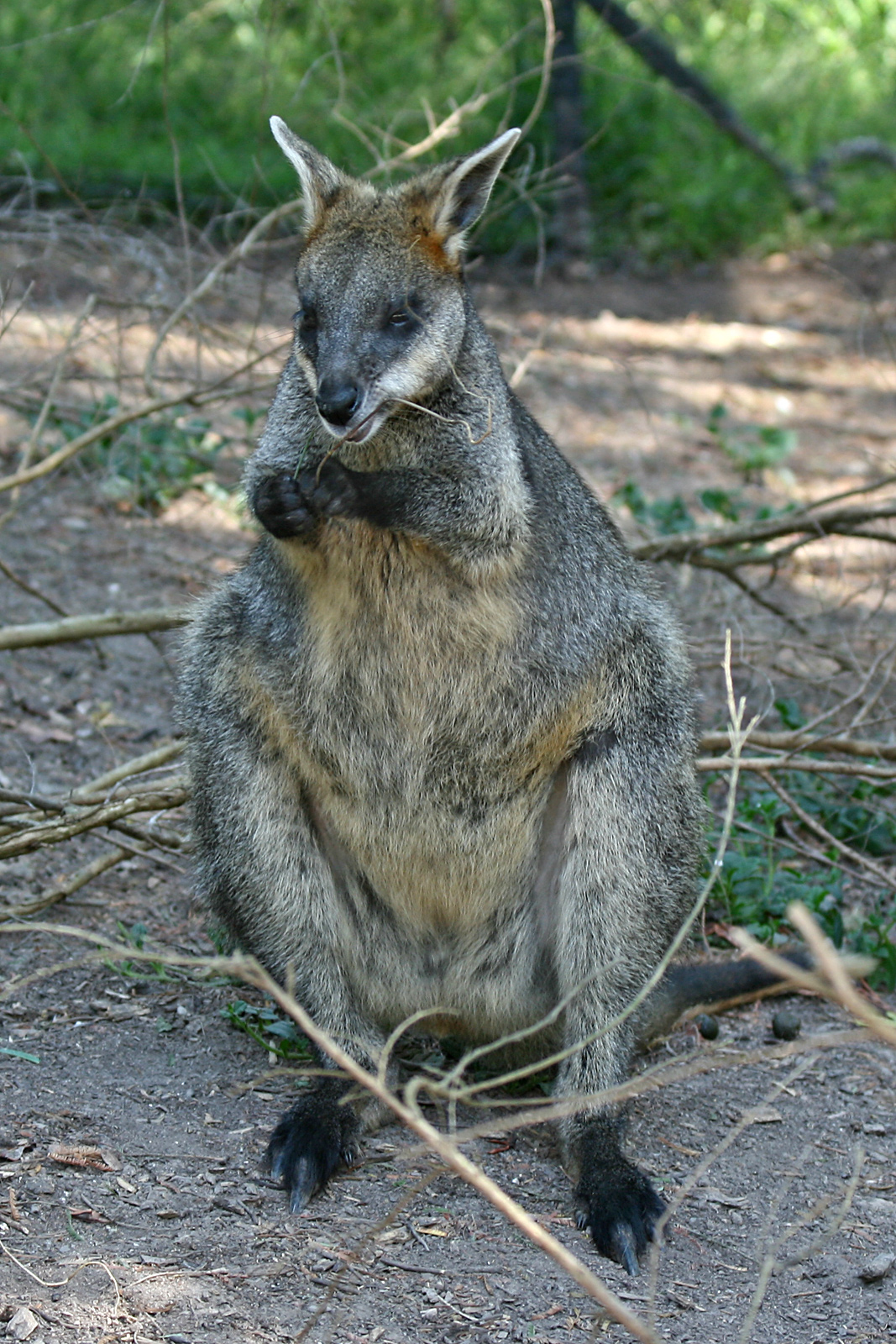- Swamp Wallaby
Taxobox
name = Swamp WallabyMSW3 Groves|pages=70|id=11000314]
status = LC
status_system = iucn3.1
status_ref = IUCN2006 | assessors = Australasian Marsupial & Monotreme Specialist Group | year = 2000 | id = 40575 | title = Wallabia bicolor | downloaded=2006-05-12 ]

regnum =Animal ia
phylum = Chordata
classis =Mammal ia
infraclassis =Marsupial ia
ordo =Diprotodontia
familia =Macropodidae
subfamilia =Macropodinae
genus = "Wallabia"
genus_authority = Trouessart, 1905
species = "W. bicolor"
binomial = "Wallabia bicolor"
binomial_authority = (Lesson, 1828)The Swamp Wallaby ("Wallabia bicolor") is a small
macropod marsupial of easternAustralia .cite book | author = Merchant, J. C. | year = 1995 | editor = Strahan, Ronald (ed) | chapter = | title = Mammals of Australia | edition = Revised edition | publisher = Reed New Holland Publishers | location = Sydney | pages = pp. 409] Thiswallaby is also commonly known as the Black Wallaby, with other names including Black-tailed Wallaby, Fern Wallaby, Black Pademelon, Stinker (inQueensland ), and Black Stinker (inNew South Wales ). The Swamp Wallaby is currently classified as the only living member of the genus "Wallabia".cite book | author = Merchant, J. C. | year = 1983 | editor = Strahan, Ronald (ed) | chapter = | title = TheAustralian Museum Complete Book of Australian Mammals, The National Photographic Index of Australian Wildlife | edition = Corrected 1991 reprint | publisher = Cornstalk Publishing | location = Australia | pages = pp.261-262 | id = ISBN 0-207-14454-0]Habitat and distribution
The Swamp Wallaby is found from the northernmost areas of Cape York in
Queensland , down the entire east coast and around to south-western Victoria. It was formerly found through to south-easternSouth Australia , but is now rare or absent from that region.The Swamp Wallaby inhabits thick undergrowth in
forest s andwoodland s, or shelter during the day in thickgrass orfern s, emerging at night to feed. Brigalow scrub in Queensland is a particularly favouredhabitat .Identification
The species name "bicolor" comes from the distinct colouring variation on the Swamp Wallaby, with the typical grey coat of the macropods varied with a dark brown to black region on the back, and light yellow to rufous orange on the chest. A light coloured cheek stripe is usually present, and extremities of the body generally show a darker colouring, except for the tip of the tail, which is often white.
The gait of the Swamp Wallaby differs from other wallabies, with the Swamp Wallaby carrying its head low and tail out straight.
The average length of the Swamp Wallaby is 76 cm for males, and 70 cm for females (excluding the tail). The tail in both sexes is approximately equal in length to the rest of the body. Average weight for males is 17 kg, with females averaging 13 kg.
Reproduction
The Swamp Wallaby becomes reproductively viable from 15-18 months of age, and can breed throughout the year.
Gestation is from 33-38 days, leading to a single young. The young is carried in the pouch from 8-9 months, but will continue to suckle until about 15 months. The Swamp Wallaby exhibits an unusual form ofembryonic diapause , differing from other marsupials in having its gestation period longer than its oestrous cycle.Nutrition
The Swamp Wallaby is typically a
solitary animal, but often aggregates into groups when feeding. It will eat a wide range offood plant s, depending on availability, includingshrub s,pasture , agricultural crops, and native and exoticvegetation . The Swamp Wallaby appears to be able to tolerate a variety of plants poisonous to many other animals, includingbracken s and hemlock.The preferred diet appears to involve browsing of
shrub s and bushes, rather thangrazing of grasses. This is unusual in wallabies and other macropods, as most typically prefer grazing.Tooth structure reflects this preference for browsing, with the shape of the molars differing from that of other wallabies. The fourthpremolar is retained through life, and is shaped for cutting through coarse plant material.According to Aboriginal people of the Bundjalung Nation, the Swamp Wallaby was considered inedible, due to its smell and taste after cooking.fact|date=May 2008 Commercial shooters also find the Swamp Wallaby undesirable due to its small size and coarse fur.
Taxonomic debate
Several physical and behavioral characteristics make the Swamp Wallaby different enough from other wallabies that many authors place it apart in its own genus, "Wallabia". Others however point out that the Swamp Wallaby can hybridize with "Macropus agilis" (the
Agile Wallaby ), so perhaps should be placed in the genus "Macropus ".fact|date=May 2008References
External links
* [http://faunanet.gov.au/wos/factfile.cfm?Fact_ID=305 Australian Museum]
* [http://home.brisnet.org.au/~mccready/Swamp%20Wallaby.htm Structure of wrist carpals]
Wikimedia Foundation. 2010.
